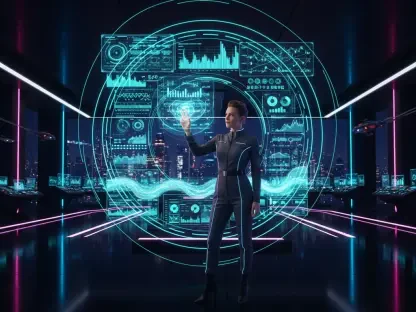In a world where customer service is the cornerstone of a business, the evolution of artificial intelligence (AI) has significantly altered the landscape, offering transformative solutions that enhance customer interactions. From its early days to contemporary applications, AI’s journey in revolutionizing customer engagement has been remarkable.
Early foundational technologies like IBM Watson, which were showcased at conferences a decade ago, marked the beginning of AI’s impactful presence in customer service. Today, AI technologies have advanced leaps and bounds, accurately delivering near-human interactions through chatbots, voice recognition systems, and data-driven insights at a fraction of previous costs. No longer just a futuristic concept, AI is actively improving customer service daily, establishing itself as a critical tool in shaping modern customer experiences.
Yet as AI becomes more embedded in customer interactions, companies are recognizing that it performs best when used strategically—not universally. Research shows that 41% of customers say automated systems make it harder to resolve their issues, especially in situations that require creativity, emotion, or nuance. This underscores the importance of keeping the human element involved.
Advancements in AI Technology
Recent advancements in natural language processing, have achieved remarkable progress in proficiency and speed. Innovations like ChatGPT have moved beyond mere text-based interaction to encompass sophisticated voice technologies. These advancements allow smart technology to provide responses that can barely be distinguished from human conversation, significantly enriching the customer service experience. Additionally, one notable AI breakthrough is the neutralization of foreign accents during customer service calls, which has long posed a challenge for offshore call centers. Artificial intelligence is now effectively addressing these linguistic barriers, enabling clearer and more effective communication that enhances both customer understanding and satisfaction.
These tools are especially powerful for handling repetitive, low-complexity tasks—such as checking account balances, tracking packages, or providing policy updates—that customers typically don’t want to spend time on. In fact, these types of tasks make up a large portion of call center volume and are ideal for automation.
Moreover, cognitive computing capabilities involve predictive insights that aid in customer interaction. This evolution allows AI-driven systems to not merely respond but to anticipate customer needs, potentially predicting follow-up questions and concerns. This level of sophistication ensures that customer interactions are smooth, efficient, and satisfactory. The resulting improvements in customer care reflect the incredible strides that AI technology has made, fundamentally changing how businesses perceive and execute their customer service strategies.
Challenges with Customer Acceptance
Despite the significant advancements in AI technology, customer acceptance of AI-driven services remains lukewarm. Research conducted by RingCentral highlights that many customers continue to experience frustration and even apprehension when interacting with AI-driven customer services. This reluctance to embrace AI solutions is often exacerbated by inconsistencies in the deployment and execution of these technologies across different companies. Such inconsistencies lead to varied and sometimes disappointing customer experiences, further discouraging the widespread acceptance of AI in customer service settings.
Interestingly, a substantial portion of customers, about 70% still show a strong preference for traditional telephone support. This preference underscores the enduring value of human agents in resolving customer queries and problems. Many customers often feel more secure and understood when interacting with human agents, especially for complex issues that require empathy and nuanced understanding. The disparity between the promise of AI technology and the actual customer experience points to a critical need for businesses to address and mitigate these acceptance challenges by refining and standardizing their AI applications.
The Crucial Role of Human Agents
While AI introduces powerful tools to the customer service arsenal, it cannot entirely replace the need for skilled human agents. Even as AI becomes more adept at handling straightforward interactions, human agents remain essential for managing complex, nuanced customer problems that smart technology might not resolve adeptly. This synthesis of advanced technology and human elements is fundamental to delivering seamless customer experiences. Businesses must strike a balance in their investment between cutting-edge tech and human resources. When technology falls short, human agents become indispensable, ensuring that customer satisfaction remains high and that intricate issues are resolved with the requisite level of empathy and expertise.
A study conducted by researchers from Stanford and MIT observed a 14% increase in the number of customer service chats successfully handled per hour by agents using AI assistance.
Verizon reported that integrating Google’s AI assistant into their customer service operations led to a nearly 40% increase in sales, as the AI helped reduce call times and allowed agents to focus more on sales activities.
Moreover, the synergy between AI and human agents can enhance the overall customer experience. AI can assist human agents by providing real-time data, insights, and even suggested responses, allowing agents to focus more on building a connection with the customer. This collaborative model leverages the strengths of both AI and human agents, resulting in a more efficient and personable customer service experience. Therefore, businesses must recognize the importance of maintaining a well-trained, responsive human workforce alongside their AI solutions to deliver the best possible customer service.
Enhancing Customer Experience
Improving customer experience (CX) holistically involves integrating sophisticated AI while maintaining strong human support. Companies increasingly recognize that meeting customer expectations requires more than the latest tech innovations; it also involves providing consistent, empathetic human interaction. Delivering exceptional customer experiences is crucial for fostering customer loyalty and encouraging repeat business. Companies aiming to achieve this goal must ensure they cater to both demands—advanced tech solutions for efficiency and reliable human support for empathy and understanding.
Moreover, the focus on creating a superior CX is clear. Businesses understand that exceeding customer expectations involves a dual approach, incorporating the latest technological tools while providing reliable human assistance. This approach not only enhances customer satisfaction but also builds lasting relationships, essential for long-term business success. By striving to meet these dual demands, companies can create customer experiences that are both efficient and deeply satisfying, ensuring they remain competitive in a rapidly evolving market.
Looking Ahead
As AI technologies continue to evolve, the next wave of adoption will focus on blending machine efficiency with emotional intelligence. Businesses are expected to use AI to enhance—not replace—human roles, allowing for faster response times without sacrificing empathy.
Looking ahead, companies that master this hybrid approach will be best positioned to deliver exceptional customer service. This means understanding when automation is appropriate and when human connection is critical—and having the tools, data, and talent in place to deliver both.
Additionally, organizations are beginning to recognize that AI implementation must be tightly aligned with broader CX strategies. Rather than deploying isolated tools, leading companies are designing end-to-end workflows where AI and agents collaborate seamlessly. This ensures continuity, reduces friction, and maximizes customer satisfaction.
Ultimately, success in customer service will come from understanding when to automate and when to humanize—and having the systems and teams in place to do both well.









